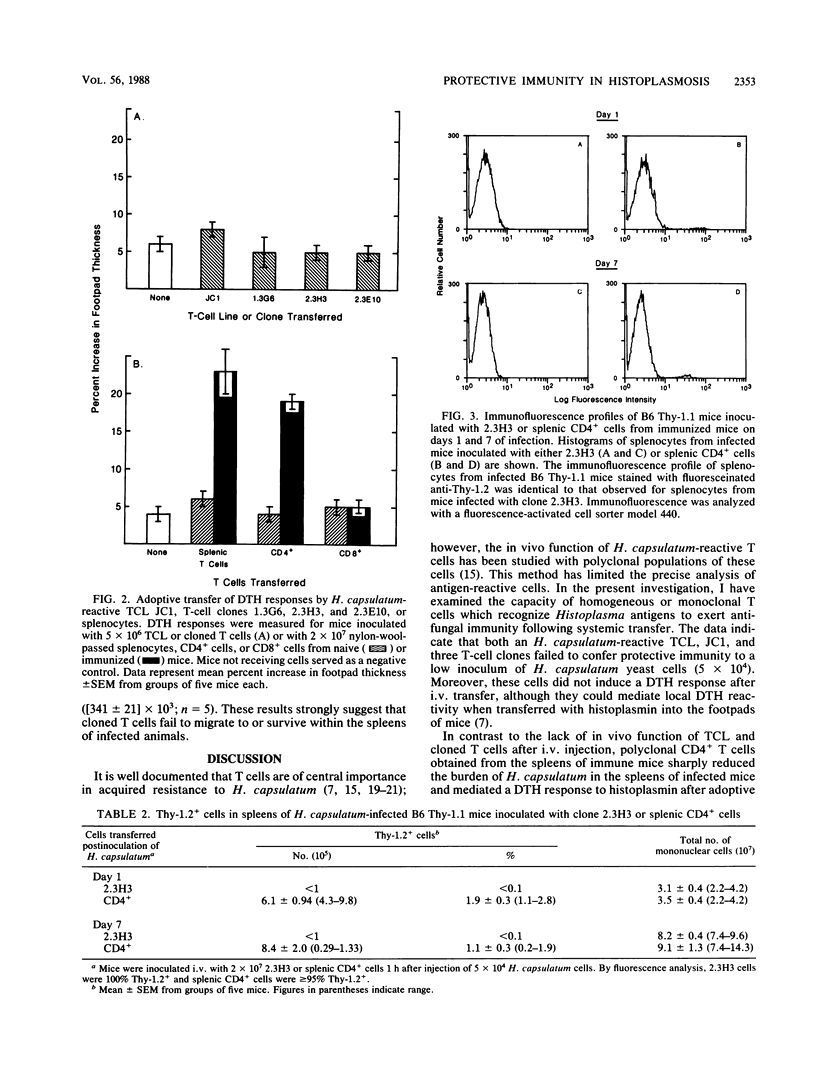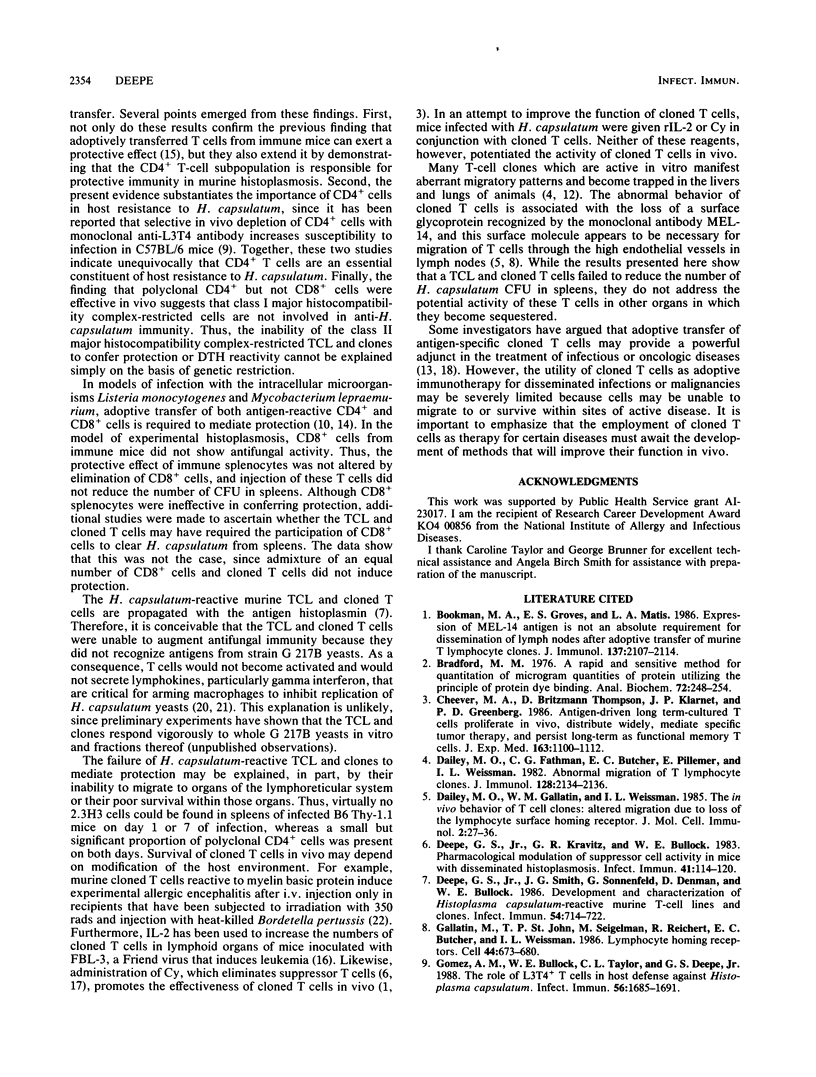Abstract
In this study, I examined whether a murine T-cell line and three clones that recognize Histoplasma capsulatum antigens in vitro could confer protection in vivo against a challenge of Histoplasma yeasts. C57BL/6 mice were each inoculated with 5 X 10(4) yeasts intravenously; 1 h later, 5 X 10(6) or 2 X 10(7) resting T cells were inoculated intravenously. At week 1 of infection, the T-cell line and all clones failed to reduce the number of H. capsulatum CFU in the spleens of mice compared with numbers in infected controls. Administration of recombinant interleukin 2 or cyclophosphamide to infected mice did not potentiate the functional activity in vivo of either the T-cell line or the clones. In contrast, inoculation with 2 X 10(7) CD4+ but not CD8+ cells isolated from the spleens of mice immunized with 10(6) viable yeast cells sharply diminished the number of CFU in the spleens of infected animals. Moreover, splenic CD4+ cells from immune mice transferred a delayed-type hypersensitivity response, whereas the T-cell line and clones did not. Injection Injection of an equal number of cloned T cells and CD8+ splenocytes from immune mice did not transfer resistance to infected mice. Additional studies were undertaken to determine if the ineffectiveness of cloned T cells was associated with a failure to migrate to and survive within spleens of infected mice. B6.PL Thy-1a/Cy mice, which are genetically identical to C57BL/6 mice except that T cells of the former bear Thy-1.1 rather than Thy-1.2, were inoculated with Histoplasma yeasts and then injected with immune CD4+ splenocytes or a T-cell clone. At days 1 and 7 of infection, virtually no Thy-1.2+ cells were detected in the spleens of infected mice given cloned T cells. However, the spleens of animals inoculated with immune CD4+ cells contained a small but significant (P less than 0.01) proportion of Thy-1.2+ cells at both day 1 and day 7 postinoculation of H. capsulatum. Thus, the failure of T-cell clones to transfer protection against H. capsulatum may be explained by defective trafficking or poor survival in vivo or both.
Full text
PDF





Selected References
These references are in PubMed. This may not be the complete list of references from this article.
- Bookman M. A., Groves E. S., Matis L. A. Expression of MEL-14 antigen is not an absolute requirement for dissemination to lymph nodes after adoptive transfer of murine T lymphocyte clones. J Immunol. 1986 Oct 1;137(7):2107–2114. [PubMed] [Google Scholar]
- Bradford M. M. A rapid and sensitive method for the quantitation of microgram quantities of protein utilizing the principle of protein-dye binding. Anal Biochem. 1976 May 7;72:248–254. doi: 10.1016/0003-2697(76)90527-3. [DOI] [PubMed] [Google Scholar]
- Cheever M. A., Thompson D. B., Klarnet J. P., Greenberg P. D. Antigen-driven long term-cultured T cells proliferate in vivo, distribute widely, mediate specific tumor therapy, and persist long-term as functional memory T cells. J Exp Med. 1986 May 1;163(5):1100–1112. doi: 10.1084/jem.163.5.1100. [DOI] [PMC free article] [PubMed] [Google Scholar]
- Dailey M. O., Fathman C. G., Butcher E. C., Pillemer E., Weissman I. Abnormal migration of T lymphocyte clones. J Immunol. 1982 May;128(5):2134–2136. [PubMed] [Google Scholar]
- Dailey M. O., Gallatin W. M., Weissman I. L. The in vivo behavior of T cell clones: altered migration due to loss of the lymphocyte surface homing receptor. J Mol Cell Immunol. 1985;2(1):27–36. [PubMed] [Google Scholar]
- Deepe G. S., Jr, Kravitz G. R., Bullock W. E. Pharmacological modulation of suppressor cell activity in mice with disseminated histoplasmosis. Infect Immun. 1983 Jul;41(1):114–120. doi: 10.1128/iai.41.1.114-120.1983. [DOI] [PMC free article] [PubMed] [Google Scholar]
- Deepe G. S., Jr, Smith J. G., Sonnenfeld G., Denman D., Bullock W. E. Development and characterization of Histoplasma capsulatum-reactive murine T-cell lines and clones. Infect Immun. 1986 Dec;54(3):714–722. doi: 10.1128/iai.54.3.714-722.1986. [DOI] [PMC free article] [PubMed] [Google Scholar]
- Gallatin M., St John T. P., Siegelman M., Reichert R., Butcher E. C., Weissman I. L. Lymphocyte homing receptors. Cell. 1986 Mar 14;44(5):673–680. doi: 10.1016/0092-8674(86)90832-9. [DOI] [PubMed] [Google Scholar]
- Gomez A. M., Bullock W. E., Taylor C. L., Deepe G. S., Jr Role of L3T4+ T cells in host defense against Histoplasma capsulatum. Infect Immun. 1988 Jul;56(7):1685–1691. doi: 10.1128/iai.56.7.1685-1691.1988. [DOI] [PMC free article] [PubMed] [Google Scholar]
- Hussein S., Curtis J., Griffiths D., Turk J. L. Study of DTH and resistance in Mycobacterium lepraemurium infection using a T-cell line isolated from mice infected with Mycobacterium bovis (BCG). Cell Immunol. 1987 Apr 1;105(2):423–431. doi: 10.1016/0008-8749(87)90089-x. [DOI] [PubMed] [Google Scholar]
- Julius M. H., Simpson E., Herzenberg L. A. A rapid method for the isolation of functional thymus-derived murine lymphocytes. Eur J Immunol. 1973 Oct;3(10):645–649. doi: 10.1002/eji.1830031011. [DOI] [PubMed] [Google Scholar]
- Kaufmann S. H. Effective antibacterial protection induced by a Listeria monocytogenes-specific T cell clone and its lymphokines. Infect Immun. 1983 Mar;39(3):1265–1270. doi: 10.1128/iai.39.3.1265-1270.1983. [DOI] [PMC free article] [PubMed] [Google Scholar]
- Kaufmann S. H., Hug E., Väth U., Müller I. Effective protection against Listeria monocytogenes and delayed-type hypersensitivity to listerial antigens depend on cooperation between specific L3T4+ and Lyt 2+ T cells. Infect Immun. 1985 Apr;48(1):263–266. doi: 10.1128/iai.48.1.263-266.1985. [DOI] [PMC free article] [PubMed] [Google Scholar]
- Kaufmann S. H. T cell clones and their products: experimental clues for the immunoprophylaxis and immunotherapy of intracellular bacterial infections? Infection. 1985;13 (Suppl 2):S177–S183. doi: 10.1007/BF01644426. [DOI] [PubMed] [Google Scholar]
- Khardori N., Chaudhary S., McConnachie P., Tewari R. P. Characterization of lymphocytes responsible for protective immunity to histoplasmosis in mice. Mykosen. 1983 Oct;26(10):523–532. [PubMed] [Google Scholar]
- Matis L. A., Shu S., Groves E. S., Zinn S., Chou T., Kruisbeek A. M., Rosenstein M., Rosenberg S. A. Adoptive immunotherapy of a syngeneic murine leukemia with a tumor-specific cytotoxic T cell clone and recombinant human interleukin 2: correlation with clonal IL 2 receptor expression. J Immunol. 1986 May 1;136(9):3496–3501. [PubMed] [Google Scholar]
- North R. J. Cyclophosphamide-facilitated adoptive immunotherapy of an established tumor depends on elimination of tumor-induced suppressor T cells. J Exp Med. 1982 Apr 1;155(4):1063–1074. doi: 10.1084/jem.155.4.1063. [DOI] [PMC free article] [PubMed] [Google Scholar]
- Rosenberg S. A., Lotze M. T., Muul L. M., Chang A. E., Avis F. P., Leitman S., Linehan W. M., Robertson C. N., Lee R. E., Rubin J. T. A progress report on the treatment of 157 patients with advanced cancer using lymphokine-activated killer cells and interleukin-2 or high-dose interleukin-2 alone. N Engl J Med. 1987 Apr 9;316(15):889–897. doi: 10.1056/NEJM198704093161501. [DOI] [PubMed] [Google Scholar]
- Williams D. M., Graybill J. R., Drutz D. J. Histoplasma capsulatum infection in nude mice. Infect Immun. 1978 Sep;21(3):973–977. doi: 10.1128/iai.21.3.973-977.1978. [DOI] [PMC free article] [PubMed] [Google Scholar]
- Wu-Hsieh B., Howard D. H. Inhibition of growth of Histoplasma capsulatum by lymphokine-stimulated macrophages. J Immunol. 1984 May;132(5):2593–2597. [PubMed] [Google Scholar]
- Wu-Hsieh B., Zlotnik A., Howard D. H. T-cell hybridoma-produced lymphokine that activates macrophages to suppress intracellular growth of Histoplasma capsulatum. Infect Immun. 1984 Jan;43(1):380–385. doi: 10.1128/iai.43.1.380-385.1984. [DOI] [PMC free article] [PubMed] [Google Scholar]
- Zamvil S., Nelson P., Trotter J., Mitchell D., Knobler R., Fritz R., Steinman L. T-cell clones specific for myelin basic protein induce chronic relapsing paralysis and demyelination. 1985 Sep 26-Oct 2Nature. 317(6035):355–358. doi: 10.1038/317355a0. [DOI] [PubMed] [Google Scholar]


